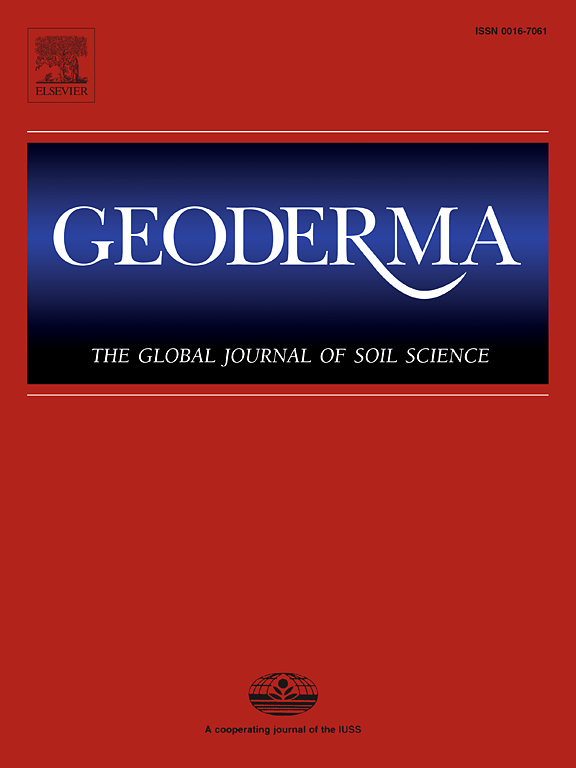用于中欧和东欧土壤数据协调和土壤分类的阳离子交换容量提取方法比较
IF 6.6
1区 农林科学
Q1 SOIL SCIENCE
引用次数: 0
摘要
阳离子交换容量和碱基饱和度对土壤特性和分类至关重要;然而,由于缺乏对世界特定地区使用不同分析方法所获得结果的比较,用于国际土壤生产力评估、土壤分类、制图和建模的土壤数据的互换性受到了限制。本研究的目的是分析中欧和东欧采用的方法测量的阳离子交换容量和碱基饱和度与世界参考基地(WRB)建议的土壤分类所需的 "标准 "技术之间的关系。这项研究使用了从波兰的 Luvisols、Retisols、Planosols、Chernozems、Phaeozems、Cambisols 和 Arenosols 采集的 183 个土壤样本,这些样本代表了广泛的质地、pH 值和有机碳含量。在非石灰性土壤中发现,在中欧和东欧测得的 "总吸附容量"(T)是碱式阳离子和 "总"("水解")酸度的总和,与使用 pH 值为 7 的 1 M 醋酸铵缓冲液测得的 "标准 "阳离子交换容量(CEC)之间具有密切的可比性。对于含有碳酸盐的土壤,由于 T 和 CEC 之间不存在关系,因此必须使用参考方法测量 CEC。根据 T 得出的 "潜在 "碱基饱和度 (V) 可以可靠地重新计算为 "标准 "碱基饱和度 (BS),这样就可以从中欧和东欧地区数据库和出版报告中检索档案数据。阳离子交换容量和碱基饱和度值之间的相似性,无论是使用当地方法还是标准方法测量或计算得出的,都可以对之前提出的当地土壤类群与 WRB 分类参考土壤类群和美国农业部土壤分类学定义的土壤等级之间的相关性进行积极的验证。据估计,"标准"、"潜在 "和 "有效 "碱基饱和度达到 50% 时的 pH 值分别为 5.5、5.2 和 4.8。尽管目前的估算值与之前报告的 50% 碱饱和度对应的 pH 临界值存在差异,但所获得的结果证实,在某些情况下(如土壤分类),土壤 pH 的实地测量值可替代实验室测量的碱饱和度。本文章由计算机程序翻译,如有差异,请以英文原文为准。
Comparison of cation exchange capacity extraction methods for soil data harmonization and soil classification in Central and East Europe
Cation exchange capacity and base saturation are of crucial importance for soil characterisation and classification; however, the interchangeability of soil data for international assessment of soil productivity, soil classification, mapping, and modelling is limited due to the lacking comparisons between results obtained using different analytical methods in particular regions of the world. The aim of the present study was to analyse the relationships between cation exchange capacity and base saturation measured using the methods adopted in Central and East Europe, and ‘standard’ techniques required for soil classification suggested by World Reference Base (WRB). This study was carried out using 183 soil samples collected from Luvisols, Retisols, Planosols, Chernozems, Phaeozems, Cambisols, and Arenosols in Poland, representing a wide range of texture, pH, and organic carbon content. A close comparability was found in noncalcareous soils between the ‘total sorption capacity’ (T) measured in Central and East Europe as the sum of base cations and ‘total’ (‘hydrolytic’) acidity, with the ‘standard’ cation exchange capacity (CEC) measured using 1 M ammonium acetate buffered at pH 7. The close correlation between T and CEC values (in noncalcareous soils) facilitates reliable data recalculation and its application in global modelling, soil classification and mapping. For soils containing carbonates, CEC must be measured using reference methods, because no relationship exists between T and CEC. The ‘potential’ base saturation (V) derived on the basis of T may be reliably recalculated to ‘standard’ base saturation (BS), allowing a retrieval of archival data from Central and East European regional databases and published reports. Similarities between the values of cation exchange capacity and base saturation, whether measured or calculated using the local and standard methods, allow a positive verification of previously proposed correlations between the local soil taxa and the reference soil groups of the WRB classification and soil orders defined by USDA Soil Taxonomy. The pH values corresponding to 50 % of ‘standard’, ‘potential’, and ‘effective’ base saturation were estimated at 5.5, 5.2, and 4.8, respectively. Irrespective of the differences between current estimates and previously reported pH threshold values corresponding to 50 % base saturation, the obtained results confirm that field measurements of soil pH may be considered a substitute for laboratory-measured base saturation for some purposes, such as soil classification.
求助全文
通过发布文献求助,成功后即可免费获取论文全文。
去求助
来源期刊

Geoderma
农林科学-土壤科学
CiteScore
11.80
自引率
6.60%
发文量
597
审稿时长
58 days
期刊介绍:
Geoderma - the global journal of soil science - welcomes authors, readers and soil research from all parts of the world, encourages worldwide soil studies, and embraces all aspects of soil science and its associated pedagogy. The journal particularly welcomes interdisciplinary work focusing on dynamic soil processes and functions across space and time.
 求助内容:
求助内容: 应助结果提醒方式:
应助结果提醒方式:


